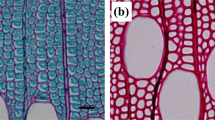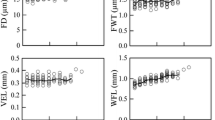Abstract
The impact of ray and vessel features on the radial air permeability and liquid penetration was compared between poplar (Populus nigra) tension and normal wood. Air permeability was measured by the falling-water volume-displacement method. To measure liquid penetration, specimens were saturated with safranin solution by the full-cell process at low pressure, and the pattern of red color penetration was then examined. Results revealed no significant difference in vessel frequency, intervessel and vessel-ray pit diameter between tension and normal wood, whereas porosity and average vessel lumen area in normal wood were significantly greater than those in tension wood. Regarding rays, their length was not different between normal and tension wood, but the latter had more frequent rays per millimeter. Since xylem rays are important flow conduits in lateral movement of fluids, it could be hypothesized that a larger number of rays in tension wood would lead to improved radial permeability. However, neither air permeability nor liquid penetration varied significantly in the studied specimens. Consequently, the results proved that ray frequency has no determining role in radial fluid flow in poplar tension and normal wood and that the share of intervessel and vessel-ray pits in radial permeability is more important.





Similar content being viewed by others
References
Ahmed SA, Chun SK (2009) Observation of liquid permeability related to anatomical characteristics in Samanea saman. Turk J Agric For 33:155–163
Ahmed SA, Chun SK (2011) Permeability of Tectona grandis L. as affected by wood structure. Wood Sci Technol 45:487–500
Ahmed SA, Chae SN, Chun SK (2007) Radial penetration of safranine in Populus tomentiglandulosa T. Lee. J Korea Furnit Soc 18:243–247
Ahmed SA, Chun SK, Miller RB, Chong SH, Kim AJ (2011) Liquid penetration in different cells of two hardwood species. J Wood Sci 57:179–188
Bradic S, Avramidis S (2007) Longitudinal air permeability of pinewood with beetle transmitted blue-stain. Holz Roh Werkst 65:183–185
Carlquist S (2007) Bordered pits in ray cells and axial parenchyma: the histology of conduction, storage, and strength in living wood cells. Bot J Linn Soc 153:157–168
Cuenderlik I, Kudela J, Molinski W (1992) Reaction beech wood in drying process. In: IUFRO 276 drying conference, Vienna, pp 350–353
Du S, Yamamoto F (2007) An overview of the biology of reaction wood formation. J Integr Plant Biol 49:131–143
EN 113 (2004) Wood preservatives—test method for determining the protective effectiveness against wood destroying basidiomycetes—Determination of the toxic values. European Committee for Standardization
Franklin GL (1945) A rapid method of softening wood for microtome sectioning. Trop Woods 88:35–36
Fujii T, Lee SJ, Kuroda N, Suzuki Y (2001) Conductive function of intervessel pits through a growth ring boundary of Machilus thunbergii. IAWA J 22:1–14
Jourez B, Riboux A, Leclercq A (2001) Anatomical characteristics of tension wood and opposite wood in young inclined stems of poplar (Populus euramericana cv’Ghoy’). IAWA J 22:133–157
Langrish T, Walker JCF (2006) Drying of timber. In: Walker JCF (ed) Primary wood processing: principles and practice. Springer, Netherlands, pp 251–295
Leal S, Sousa VB, Pereira H (2007) Radial variation of vessel size and distribution in cork oak wood (Quercus suber L.). Wood Sci Technol 41:339–350
Perré P (2007) Fluid migration in wood. In: Perré P. (ed) Fundamentals of wood drying. A.R.BO. LOR., Nancy, pp 125–156
Rayirath P, Avramidis S (2008) Some aspects of western hemlock air permeability. Maderas Cienc tecnol 10:185–193
Ruelle J (2014) Morphology, anatomy and ultrastructure of reaction wood. In: Gardiner B, Barnett J, Saranpää P, Gril J (eds) The biology of reaction wood. Springer, Berlin, pp 13–35
Ruelle J, Clair B, Beauchêne J, Prévost MF, Fournier M (2006) Tension wood and opposite wood in 21 tropical rain forest species. Comparison of some anatomical and ultrastructural criteria. IAWA J 27:341–376
Sano Y (2004) Intervascular pitting across the annual ring boundary in Betula platyphylla var. japonica and Fraxinus mandshurica var. japonica. IAWA J 25:129–140
Sayar M, Tarmian A (2013) Modification of water vapor diffusion in poplar wood (Populus nigra L.) by steaming at high temperatures. Turk J Biol 37:511–515
Siau JF (1984) Transport processes in wood. Springer, Berlin
Siau JF (1995) Permeability. In: Siau JF (ed) Wood: influence of moisture on physical properties. Virginia Polytechnic Institute and State University, Blacksburg, pp 39–58
Silva MR, Machado GO, Deiner J, Calil C (2010) Permeability measurements of brazilian eucalyptus. Mat Res 13(3):281–286
Spicer R, Gartner BL (2002) Compression wood has little impact on the water relations of Douglas-fir (Pseudotsuga menziesii) seedlings despite a large effect on shoot hydraulic properties. New Phytol 154:633–640
Straze A, Gorisek Z (2006) Drying characteristics of compression wood in Norway spruce (Picea abies Karst.). In: Kurjatko S, Kudela J, Lagana R (eds) Wood structure and properties. Arbora Publishers, Zvolen, pp 399–403
Taghiyari HR (2012) Correlation between gas and liquid permeability in some nanosilver-impregnated and untreated hardwood. J Trop For Sci 24(2):249–255
Taghiyari HR (2013) Effects of heat-treatment on permeability of untreated and nanosilver—impregnated native hardwoods. Maderas Cienc tecnol 15:183–194
Taghiyari HR, Karimi AN, Parsapajouh D, Pourtahmasi K (2010) Study on the longitudinal gas permeability of juvenile wood and mature wood. STRPM 1(1):31–38
Tarmian A, Perré P (2009) Air permeability in longitudinal and radial directions of compression wood of Picea abies L. and tension wood of Fagus sylvatica L. Holzforschung 63:352–356
Tarmian A, Remond R, Faezipour M, Karimi K, Perré P (2009) Reaction wood drying kinetics: Compression wood in Picea abies and tension wood in Fagus sylvatica. Wood Sci Technol 43:113–130
Timell TE (1986) Compression wood in gymnosperms. Springer-Verlag, New York
Tsai CJ, Chien CT, Lee CM, Chen SJ, Kuo-Huang LL (2006) Anatomical characteristics of artificially induced tension wood in seedlings of Honduras mahogany. Taiwan J for Sci 21:147–154
Van Bel AJ (1990) Xylem-phloem exchange via the rays: The undervalued route of transport. J Exp Bot 41:631–644
Wilson BF (1984) The growing tree. University of Massachusetts Press, Amherst
Acknowledgments
The authors acknowledge the financial support from the Scientific Center of Excellence for the Applied Management of Fast Growing Wooden Species at the University of Tehran.
Author information
Authors and Affiliations
Corresponding author
Rights and permissions
About this article
Cite this article
Emaminasab, M., Tarmian, A., Oladi, R. et al. Fluid permeability in poplar tension and normal wood in relation to ray and vessel properties. Wood Sci Technol 51, 261–272 (2017). https://doi.org/10.1007/s00226-016-0860-y
Received:
Published:
Issue Date:
DOI: https://doi.org/10.1007/s00226-016-0860-y




